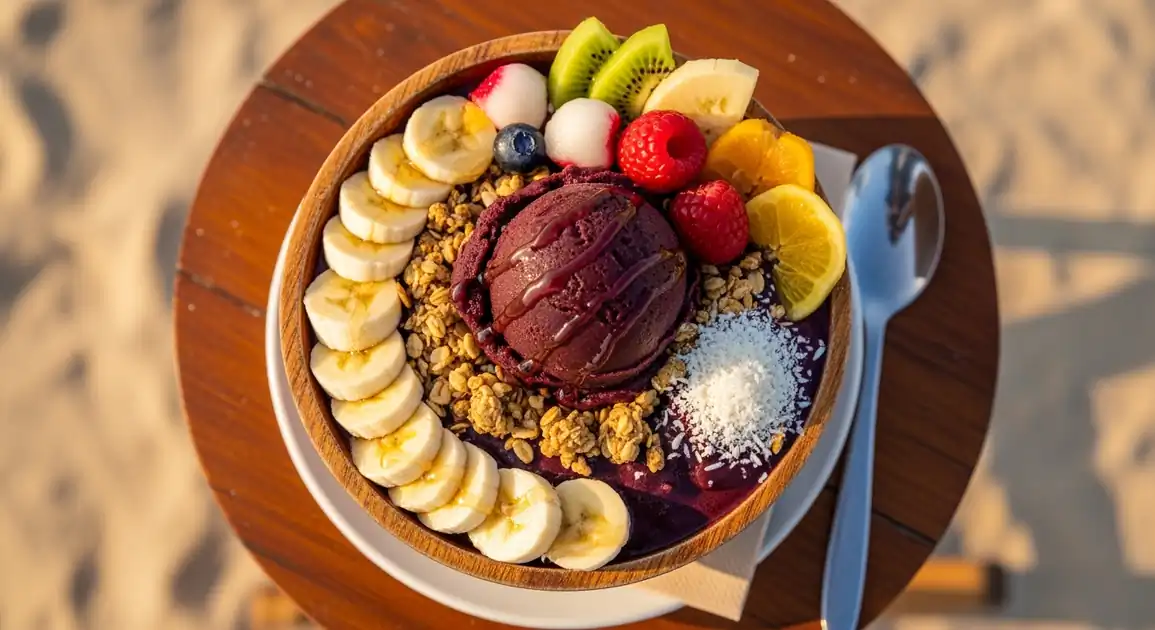Açaí Bowl
Açaí na Tigela

Description
Açaí na tigela is beloved throughout Brazil, though its preparation varies by region. In the Amazon (its native region), açaí is often served unsweetened and paired with savory foods. In southern Brazil, including Rio, it's transformed into a sweeter dish with granola and fruits. While once seasonal, frozen açaí is now available year-round, making it a constant in Brazilian food culture from beach kiosks to shopping malls.
Dietary Information
Serving information
Serving style
Served in a bowl ('tigela') or cup with a spoon. Traditionally eaten immediately while still frozen and firm.
Quick facts
Most juice bars and açaí shops operate from 8 AM - 8 PM, while beach vendors typically sell from 9 AM - 6 PM.
Safety Tips
What to Look For
-
Thick, sorbet-like consistency
Quality açaí should be thick enough to eat with a spoon, not drink. Watery açaí may indicate over-dilution with potentially unsafe water or ice.
-
Deep purple color (not artificially bright)
Natural açaí has a deep, almost black-purple hue. Overly bright purple color can indicate artificial additives.
-
Fresh, crisp toppings
Granola should be crunchy, fruit toppings should be freshly cut and vibrant in color.
-
Clean preparation area and utensils
Observe how ingredients are stored and handled. Toppings should be in clean, covered containers.
-
High customer turnover
Busy shops ensure ingredients don't sit out long and are replenished frequently.
What to avoid
-
Pre-made bowls sitting in display cases
Açaí should ideally be prepared to order for optimal freshness and texture.
-
Watery or melting açaí
This indicates poor quality or that it's been sitting out too long, increasing risk of contamination.
-
Uncovered topping stations exposed to air/insects
Toppings should be protected in covered containers, especially in beach areas.
-
Visibly wilted or browning fruit toppings
Indicates old ingredients and poor inventory management.
-
Vendors using the same scoop for different toppings without washing
Can cause cross-contamination issues for those with allergies.
Price information
Price range
Budget tips
- Small açaí bowls ('açaí pequeno') typically cost 10-15 BRL and are often enough for a snack.
- Beach vendors usually charge 3-5 BRL more than inland juice bars for the same size.
- Adding extra toppings beyond granola and banana typically costs 2-4 BRL each.
- Many places offer combo deals with a sandwich or tapioca (Brazilian pancake) at a discount.
Value indicators
- Thickness of the açaí (thicker means less dilution with water/ice).
- Generous portion of toppings without extra charges.
- Use of branded, high-quality açaí base (like Frooty or Juçaí).
- Made-to-order preparation rather than pre-made bowls.
Where to Find This Dish
Beach Areas
Concentrated along beach promenades and within beach kiosks ('quiosques').
Beachfront kiosks, Promenades, Surf schools
10 AM - 6 PM
Commercial Districts
Juice bars ('casas de sucos') and dedicated açaí shops in shopping areas.
Shopping malls, Commercial streets, Near offices
11 AM - 2 PM, 5 PM - 7 PM
Fitness Areas
Near gyms and sports facilities for pre/post-workout nutrition.
Gyms, Sports clubs, Parks with workout equipment
Early morning, Evening
Vendor Tips
- Ask for 'açaí puro' if you want less sweet açaí without guaraná syrup.
- 'Cremoso' indicates a creamier texture, while 'grosso' means thicker consistency.
- Request to see the açaí brand they use – established brands like Frooty, Juçaí, or 100% Amazônia generally indicate better quality.
How to Order
Regional Variations
-
Traditional Açaí Bowl
(Açaí Tradicional)
The classic preparation with açaí base topped with granola and sliced banana, sometimes with honey.
-
Açaí with Strawberry
(Açaí com Morango)
Adds fresh strawberry slices to the traditional toppings for a more colorful and vitamin-rich bowl.
-
Açaí with Condensed Milk
(Açaí com Leite Condensado)
Features a drizzle of sweet condensed milk over the açaí, popular with those who enjoy a sweeter version.
-
Protein Açaí
(Açaí Proteico)
Health-focused variation with added protein powder, often with extra nuts or seeds.
-
Açaí Mix
(Açaí Mix or Mixxaí)
Blends açaí with other fruits like strawberry, banana, or guaraná in the base before adding toppings.
-
Açaí Cup
(Copo de Açaí)
Layered parfait-style presentation in a cup rather than a bowl, with alternating layers of açaí and toppings.
-
Detox Açaí
(Açaí Detox)
Health-oriented version with added seeds (chia, flax), often unsweetened and with additional superfoods.
Cultural context
History
Açaí has been a staple food of indigenous Amazonian tribes for centuries. Originally consumed as a energy-boosting food by riverine populations in northern Brazil, açaí na tigela as we know it today emerged in the 1980s when the frozen pulp began to be transported to southern Brazil, particularly Rio de Janeiro. Surfers in Rio popularized açaí bowls as the perfect post-surf refreshment, valuing its energizing properties. From beachside consumption, it evolved into a national phenomenon and eventually gained international recognition as a superfood in the early 2000s.
Local significance
Açaí represents Brazil's connection to the Amazon's biodiversity and has become a symbol of the healthy, active beach lifestyle that defines coastal Brazilian culture.
Eating customs
- Eaten with a spoon directly from the bowl/cup while still frozen.
- Mixing the toppings into the açaí before eating is common.
- Often shared among friends at the beach.